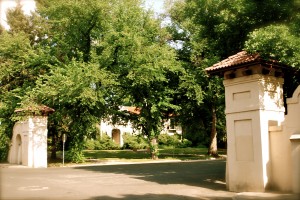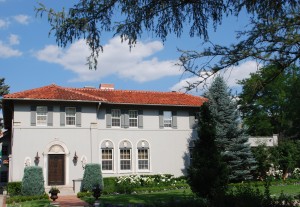
 The Fourth Avenue Realty Company chose William E. Fisher as its primary designer. He designed landscaped parkways as part of the defining characteristic of the neighborhood, inspired by Frederick Law Olmstead, and designed the Mediterranean Gateway along 4th Avenue, which was the original entrance to the Denver Country Club. The district nicknamed the “Spanish Suburb” is beautifully landscaped and incorporates some of Denver’s finest examples of early 20th century architectural styles, such as the Denver Square, Gothic, Colonial, and Mediterranean Revivals. Denver’s most prominent architects, including Fisher and Fisher, Benedict, Biscoe, Gove and Walsh, and Varian and Sterner, designed many of the houses. Many of which, have remained in families for three to four generations.
The Fourth Avenue Realty Company chose William E. Fisher as its primary designer. He designed landscaped parkways as part of the defining characteristic of the neighborhood, inspired by Frederick Law Olmstead, and designed the Mediterranean Gateway along 4th Avenue, which was the original entrance to the Denver Country Club. The district nicknamed the “Spanish Suburb” is beautifully landscaped and incorporates some of Denver’s finest examples of early 20th century architectural styles, such as the Denver Square, Gothic, Colonial, and Mediterranean Revivals. Denver’s most prominent architects, including Fisher and Fisher, Benedict, Biscoe, Gove and Walsh, and Varian and Sterner, designed many of the houses. Many of which, have remained in families for three to four generations.  The Country Club neighborhood’s significance was recognized in 1979 when the western half of the district was listed in the National Register of Historic Places. The Country Club Historic District was designated as a Landmark District in 1990. The L-shaped district comprised of 380 residences, most of which were constructed in 1902 through 1945, was found to qualify as a Landmark district because of its historical, architectural, and geographical significance. The rich architectural history of this neighborhood is now protected, and the Commission must approve any proposed changes before a permit can be issued. Attracted to the large lots, beautiful landscaping and architecture, many of Denver’s political, social and economic elite made the Country Club neighborhood home, including Mayor Speer, founder’s of most of Denver’s banks, and heads of Denver’s major oil, mining and real estate industries. The neighborhood is anchored by the Denver Country Club, which remains one of the finest country clubs west of the Mississippi. The Country Club had many infamous members, including the “Unsinkable” Molly Brown, “Baby Doe” Tabor and President Dwight D. Eisenhower. The Historic Country Club District is a neighborhood like no other in Denver due to its beauty, grandeur, historical preservation, and close proximity to the now posh Cherry Creek Shopping District, and Downtown Denver. The district is a prime place to live. For more information about homes available in the Historic Country Club District or any other real estate or investment needs, please contact Jesse Sehlemeyer at 303-564-2245.
The Country Club neighborhood’s significance was recognized in 1979 when the western half of the district was listed in the National Register of Historic Places. The Country Club Historic District was designated as a Landmark District in 1990. The L-shaped district comprised of 380 residences, most of which were constructed in 1902 through 1945, was found to qualify as a Landmark district because of its historical, architectural, and geographical significance. The rich architectural history of this neighborhood is now protected, and the Commission must approve any proposed changes before a permit can be issued. Attracted to the large lots, beautiful landscaping and architecture, many of Denver’s political, social and economic elite made the Country Club neighborhood home, including Mayor Speer, founder’s of most of Denver’s banks, and heads of Denver’s major oil, mining and real estate industries. The neighborhood is anchored by the Denver Country Club, which remains one of the finest country clubs west of the Mississippi. The Country Club had many infamous members, including the “Unsinkable” Molly Brown, “Baby Doe” Tabor and President Dwight D. Eisenhower. The Historic Country Club District is a neighborhood like no other in Denver due to its beauty, grandeur, historical preservation, and close proximity to the now posh Cherry Creek Shopping District, and Downtown Denver. The district is a prime place to live. For more information about homes available in the Historic Country Club District or any other real estate or investment needs, please contact Jesse Sehlemeyer at 303-564-2245. Copyright © 2021 Vintage Homes of Denver
Real Estate Website Design by High Elevation